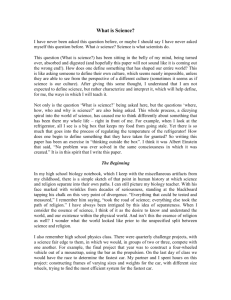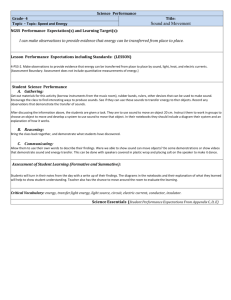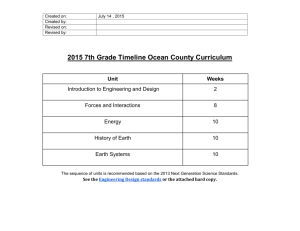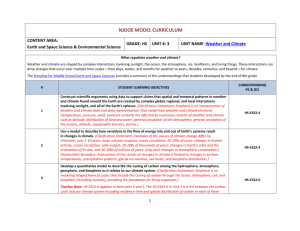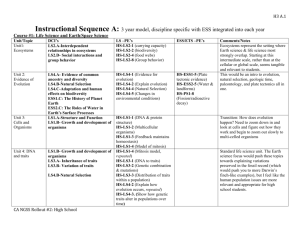7th Grade Pacing Guide - Fleming County Schools
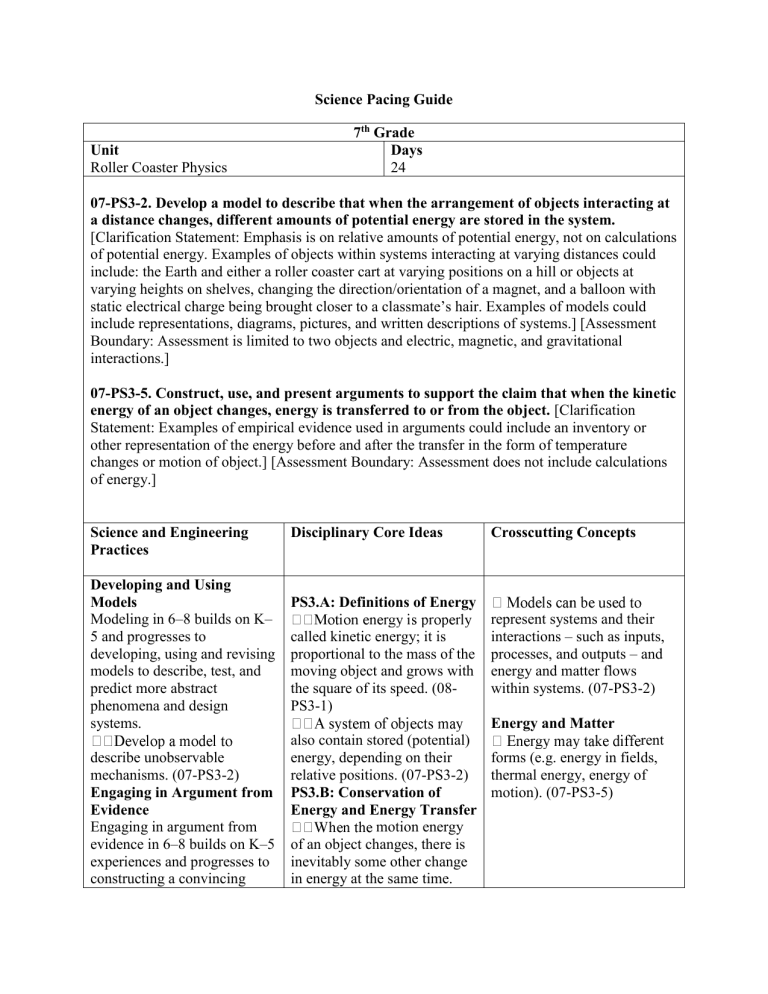
Science Pacing Guide
Unit
Roller Coaster Physics
7 th Grade
Days
24
07-PS3-2. Develop a model to describe that when the arrangement of objects interacting at a distance changes, different amounts of potential energy are stored in the system.
[Clarification Statement: Emphasis is on relative amounts of potential energy, not on calculations of potential energy. Examples of objects within systems interacting at varying distances could include: the Earth and either a roller coaster cart at varying positions on a hill or objects at varying heights on shelves, changing the direction/orientation of a magnet, and a balloon with static electrical charge being brought closer to a classmate’s hair. Examples of models could include representations, diagrams, pictures, and written descriptions of systems.] [Assessment
Boundary: Assessment is limited to two objects and electric, magnetic, and gravitational interactions.]
07-PS3-5. Construct, use, and present arguments to support the claim that when the kinetic energy of an object changes, energy is transferred to or from the object. [Clarification
Statement: Examples of empirical evidence used in arguments could include an inventory or other representation of the energy before and after the transfer in the form of temperature changes or motion of object.] [Assessment Boundary: Assessment does not include calculations of energy.]
Science and Engineering
Practices
Disciplinary Core Ideas Crosscutting Concepts
Developing and Using
Models
Modeling in 6–8 builds on K–
5 and progresses to developing, using and revising models to describe, test, and predict more abstract phenomena and design systems. describe unobservable mechanisms. (07-PS3-2)
Engaging in Argument from
Evidence
Engaging in argument from evidence in 6–8 builds on K–5 experiences and progresses to constructing a convincing
PS3.A: Definitions of Energy called kinetic energy; it is proportional to the mass of the moving object and grows with the square of its speed. (08-
PS3-1) also contain stored (potential) energy, depending on their relative positions. (07-PS3-2)
PS3.B: Conservation of
Energy and Energy Transfer
motion energy of an object changes, there is inevitably some other change in energy at the same time. represent systems and their interactions – such as inputs, processes, and outputs – and energy and matter flows within systems. (07-PS3-2)
Energy and Matter rent forms (e.g. energy in fields, thermal energy, energy of motion). (07-PS3-5)
argument that supports or refutes claims for either explanations or solutions about the natural and designed worlds.
(07-PS3-5)
PS3.C: Relationship
Between Energy and Forces oral and written arguments supported by empirical evidence and scientific reasoning to support or refute an explanation or a model for a phenomenon. (07-PS3-5)
Connections to Nature of
Science
Scientific Knowledge is
Based on Empirical
Evidence each one exerts a force on the other that can cause energy to be transferred to or from the object. (07-PS3-2) based upon logical and conceptual connections between evidence and explanations (07-PS3-4),(07-
PS3-5)
Connections to other DCIs in this grade-band:
MS.PS1.A (07-PS3-4); MS.PS1.B (07-PS3-3); MS.PS2.A (08-PS3-1),(07-PS3-4),(07-PS3-5);
MS.ESS2.A (07-PS3-3); MS.ESS2.C (07-PS3-3),(07-PS3-4); MS.ESS2.D (07-PS3-3),(07-PS3-
4); MS.ESS3.D (07-PS3-4)
Articulation to DCIs across grade-bands:
4.PS3.B (08-PS3-1),(07-PS3-3); 4.PS3.C (07-PS3-4),(07-PS3-5); HS.PS1.B (07-PS3-4);
HS.PS2.B (07-PS3-2); HS.PS3.A (08-PS3-1),(07-PS3-4),(07-PS3-5); HS.PS3.B (08-PS3-
1),(07-PS3-2),(07-PS3-3),(07-PS3-4),(07-PS3-5); HS.PS3.C (07-PS3-2)
Common Core State Standards Connections:
ELA/Literacy –
Common Core State Standards Connections:
ELA/Literacy –
RST.6-8.1 Cite specific textual evidence to support analysis of science and technical texts, attending to the precise details of explanations or descriptions (07-PS3-5)
WHST.6-8.1 Write arguments focused on discipline content. (07-PS3-5)
SL.8.5 Integrate multimedia and visual displays into presentations to clarify information, strengthen claims and evidence, and add interest. (07-PS3-2)
Mathematics –
MP.2 Reason abstractly and quantitatively. (07-PS3-4),(07-PS3-5)
6.RP.A.1
Understand the concept of ratio and use ratio language to describe a ratio relationship between two quantities. (07-PS3-5)
7.RP.A.2
Recognize and represent proportional relationships between quantities.(07-PS3-5)
8.F.A.3
Interpret the equation y = mx + b as defining a linear function, whose graph is a straight line; give examples of functions that are not linear. 07-PS3-5)
Learning Targets:
I Can…..
1.
Explain the difference in potential and kinetic energy.
2.
Identify and categorize the different types of energy.
3.
Identify the different types of energy in a system.
4.
Explain how energy is transferred.
5.
Explain the Law of Conservation of Energy
Unit
Save the Snowman
7 th Grade
Days
20
07-PS3-3. Apply scientific principles to design, construct, and test a device that either minimizes or maximizes thermal energy transfer.* [Clarification Statement: Examples of devices could include an insulated box, a solar cooker, and a Styrofoam cup.] [Assessment
Boundary: Assessment does not include calculating the total amount of thermal energy transferred.]
07-PS3-4. Plan an investigation to determine the relationships among the energy transferred, the type of matter, the mass, and the change in the average kinetic energy of the particles as measured by the temperature of the sample.
[Clarification Statement: Examples of experiments could include comparing final water temperatures after different masses of ice melted in the same volume of water with the same initial temperature, the temperature change of samples of different materials with the same mass as they cool or heat in the environment, or the same material with different masses when a specific amount of energy is added.] [Assessment Boundary: Assessment does not include calculating the total amount of thermal energy transferred.]
Science and Engineering
Practices
Disciplinary Core Ideas Crosscutting Concepts
Planning and Carrying Out
Investigations
Planning and carrying out investigations to answer questions or test solutions to problems in 6–8 builds on K–
5 experiences and progresses to include investigations that use multiple variables and provide evidence to support explanations or design solutions. individually and collaboratively, and in the design: identify independent and dependent variables and controls, what tools are needed to do the gathering, how measurements will be recorded, and how many data are needed to support a claim.
(07-PS3-4)
PS3.A: Definitions of Energy of the average kinetic energy of particles of matter. The relationship between the temperature and the total energy of a system depends on the types, states, and amounts of matter present. (07-PS3-
3),(07-PS3-4)
PS3.B: Conservation of
Energy and Energy Transfer energy transfer needed to change the temperature of a matter sample by a given amount depends on the nature of the matter, the size of the sample, and the environment. (07-PS3-
Scale, Proportion, and
Quantity ships
(e.g. speed as the ratio of distance traveled to time taken) among different types of quantities provide information about the magnitude of properties and processes. (08-PS3-1),(07-
PS3-4)
Energy and Matter can be tracked as energy flows through a designed or natural system. (07-PS3-3)
Constructing Explanations and Designing Solutions
Constructing explanations and designing solutions in 6–8 builds on K–5 experiences and progresses to include constructing explanations and designing solutions supported by multiple sources of evidence consistent with scientific ideas, principles, and theories.
4) transferred out of hotter regions or objects and into colder ones. (07-PS3-3)
ETS1.A: Defining and
Delimiting an Engineering
Problem principles to design, construct, and test a design of an object, tool, process or system. (07-
PS3-3)
Connections to Nature of
Science
Scientific Knowledge is
Based on Empirical
Evidence design task’s criteria and constraints can be defined, the more likely it is that the designed solution will be successful. Specification of constraints includes consideration of scientific principles and other relevant knowledge that is likely to limit possible solutions.
(secondary to 07-PS3-3)
ETS1.B: Developing Possible
Solutions based upon logical and conceptual connections between evidence and explanations (07-PS3-4),(07-
PS3-5) tested, and then modified on the basis of the test results in order to improve it. There are systematic processes for evaluating solutions with respect to how well they meet criteria and constraints of a problem. (secondary to 07-
PS3-3)
Connections to other DCIs in this grade-band:
MS.PS1.A (07-PS3-4); MS.PS1.B (07-PS3-3); MS.PS2.A (08-PS3-1),(07-PS3-4),(07-PS3-5);
MS.ESS2.A (07-PS3-3); MS.ESS2.C (07-PS3-3),(07-PS3-4); MS.ESS2.D (07-PS3-3),(07-PS3-
4); MS.ESS3.D (07-PS3-4)
Articulation to DCIs across grade-bands:
4.PS3.B (08-PS3-1),(07-PS3-3); 4.PS3.C (07-PS3-4),(07-PS3-5); HS.PS1.B (07-PS3-4);
HS.PS2.B (07-PS3-2); HS.PS3.A (07-PS3-4),(07-PS3-5); HS.PS3.B (07-PS3-2),(07-PS3-
3),(07-PS3-4),(07-PS3-5); HS.PS3.C (07-PS3-2)
Common Core State Standards Connections:
ELA/Literacy –
RST.6-8.3 Follow precisely a multistep procedure when carrying out experiments, taking measurements, or performing technical tasks. (07-PS3-3),(07-PS3-4)
WHST.6-8.7 Conduct short research projects to answer a question (including a self-generated question), drawing on several sources and generating additional related, focused questions that allow for multiple avenues of exploration. (07-PS3-3),(07-PS3-4)
Mathematics –
MP.2 Reason abstractly and quantitatively. (07-PS3-4),(07-PS3-5)
8.F.A.3
Interpret the equation y = mx + b as defining a linear function, whose graph is a straight line; give examples of functions that are not linear. (07-PS3-5)
6.SP.B.5
Summarize numerical data sets in relation to their context. (07-PS3-4)
Learning Targets:
I Can…..
1.
Explain how thermal energy is transferred.
2.
Design, Construct, and Test a devise to minimize or maximize thermal energy transfer.
3. Plan an investigation to determine the relationship among the energy transferred, the type of matter, the mass and the change in the average kinetic energy of particles measured by temperature.
Unit
Use the Force
7 th Grade
Days
15
07-PS2-3. Ask questions about data to determine the factors that affect the strength of electric and magnetic forces. [Clarification Statement: Examples of devices that use electric and magnetic forces could include electromagnets, electric motors, or generators. Examples of data could include the effect of the number of turns of wire on the strength of an electromagnet, or the effect of increasing the number or strength of magnets on the speed of an electric motor.]
[Assessment Boundary: Assessment about questions that require quantitative answers is limited to proportional reasoning and algebraic thinking.]
07-PS2-4. Construct and present arguments using evidence to support the claim that gravitational interactions are attractive and depend on the masses of interacting objects.
[Clarification Statement: Examples of evidence for arguments could include data generated from simulations or digital tools; and charts displaying mass, strength of interaction, distance from the
Sun, and orbital periods of objects within the solar system.] [Assessment Boundary: Assessment does not include Newton’s Law of Gravitation or Kepler’s Laws.]
07-PS2-5. Conduct an investigation and evaluate the experimental design to provide evidence that fields exist between objects exerting forces on each other even though the objects are not in contact. [Clarification Statement: Examples of this phenomenon could include the interactions of magnets, electrically-charged strips of tape, and electrically-charged pith balls. Examples of investigations could include first-hand experiences or simulations.]
[Assessment Boundary: Assessment is limited to electric and magnetic fields. Assessment is limited to qualitative evidence for the existence of fields.]
Science and Engineering
Practices
Disciplinary Core Ideas Crosscutting Concepts
Asking Questions and
Defining Problems
Asking questions and defining problems in grades 6–8 builds from grades K–5 experiences and progresses to specifying relationships between variables, and clarifying arguments and models.
PS2.B: Types of Interactions
(electromagnetic) forces can be attractive or repulsive, and their sizes depend on the magnitudes of the charges, currents, or magnetic strengths involved and on the distances between the interacting objects. (07-PS2-3)
Cause and Effect investigated within the scope of the classroom, outdoor environment, and museums and other public facilities with available resources and, when always attractive. There is a gravitational force between any two masses, but it is very relationships may be used to predict phenomena in natural or designed systems. (07-PS2-
3),(07-PS2-5)
Systems and System Models represent systems and their interactions—such as inputs, processes and outputs—and energy and matter flows within systems. (06-PS2-
1),(07-PS2-4),
appropriate, frame a hypothesis based on observations and scientific principles. (07-PS2-3)
Planning and Carrying Out
Investigations
Planning and carrying out investigations to answer questions or test solutions to problems in 6–8 builds on K–
5 experiences and progresses to include investigations that use multiple variables and provide evidence to support explanations or design solutions. n investigation and evaluate the experimental design to produce data to serve as the basis for evidence that can meet the goals of the investigation. (07-PS2-5)
Engaging in Argument from
Evidence
Engaging in argument from evidence in 6–8 builds from
K–5 experiences and progresses to constructing a convincing argument that supports or refutes claims for either explanations or solutions about the natural and designed world. small except when one or both of the objects have large mass—e.g., Earth and the sun.
(07-PS2-4) distance (electric, magnetic, and gravitational) can be explained by fields that extend through space and can be mapped by their effect on a test object (a charged object, or a ball, respectively). (07-
PS2-5) and written arguments supported by empirical evidence and scientific reasoning to support or refute an explanation or a model for a phenomenon or a solution to a problem. (07-PS2-4)
Connections to Nature of
Science
Scientific Knowledge is
Based on Empirical
Evidence based upon logical and conceptual connections between evidence and explanations. (06-PS2-2),(07-
PS2-4)
Connections to other DCIs in this grade-band:
MS.ESS1.A (07-PS2-4); MS.ESS1.B (07-PS2-4); MS.ESS2.C (07-PS2-4)
Articulation to DCIs across grade-bands:
3.PS2.B (07-PS2-3),(07-PS2-5); 5.PS2.B (07-PS2-4); HS.PS2.B (07-PS2-3),(07-PS2-4),(07-
PS2-5); HS.PS3.A (07-PS2-5); HS.PS3.B (07-PS2-5); HS.PS3.C (07-PS2-5); HS.ESS1.B (07-
PS2-4)
Common Core State Standards Connections:
ELA/Literacy –
RST.6-8.1 Cite specific textual evidence to support analysis of science and technical texts, attending to the precise details of explanations or descriptions (07-PS2-3)
RST.6-8.3 Follow precisely a multistep procedure when carrying out experiments, taking measurements, or performing technical tasks. ((07-PS2-5)
WHST.6-8.1 Write arguments focused on discipline-specific content. (07-PS2-4)
WHST.6-8.7 Conduct short research projects to answer a question (including a self-generated question), drawing on several sources and generating additional related, focused questions that allow for multiple avenues of exploration. (07-PS2-5)
Mathematics –
MP.2 Reason abstractly and quantitatively. (07-PS2-3)
Learning Targets:
I Can…..
1.
Identify and describe factors that affect the strength of electric and magnetic forces.
2.
Generate questions about data to explain the factors that affect the strength of electric and magnetic forces.
3.
Create an argument supported by evidence to support the claim that gravitational interactions are attractive and depend on the mass of the objects.
4.
Conduct an investigation and evaluate the design of the experiment to provide evidence that fields exist between objects exerting force on each other.
Unit
Communicating with a Wave
7 th Grade
Days
17
07-PS4-1. Use mathematical representations to describe a simple model for waves that includes how the amplitude of a wave is related to the energy in a wave. [Clarification
Statement: Emphasis is on describing waves with both qualitative and quantitative thinking.]
[Assessment Boundary: Assessment does not include electromagnetic waves and is limited to standard repeating waves.]
07-PS4-2. Develop and use a model to describe that waves are reflected, absorbed, or transmitted through various materials. [Clarification Statement: Emphasis is on both light and mechanical waves. Examples of models could include drawings, simulations, and written descriptions.] [Assessment Boundary: Assessment is limited to qualitative applications pertaining to light and mechanical waves.]
07-PS4-3. Integrate qualitative scientific and technical information to support the claim that digitized signals are a more reliable way to encode and transmit information than analog signals. [Clarification Statement: Emphasis is on a basic understanding that waves can be used for communication purposes. Examples could include using fiber optic cable to transmit light pulses, radio wave pulses in wifi devices, and conversion of stored binary patterns to make sound or text on a computer screen.] [Assessment Boundary: Assessment does not include binary counting. Assessment does not include the specific mechanism of any given device.]
Disciplinary Core Ideas Crosscutting Concepts Science and Engineering
Practices
Developing and Using
Models
Modeling in 6–8 builds on K–
5 and progresses to developing, using, and revising models to describe, test, and predict more abstract phenomena and design systems. to describe phenomena. (07-
PS4-2)
Using Mathematics and
Computational Thinking
Mathematical and computational thinking at the
6–8 level builds on K–5 and progresses to identifying patterns in large data sets and using mathematical concepts
Developing and Using
Models
Modeling in 6–8 builds on K–
5 and progresses to developing, using, and revising models to describe, test, and predict more abstract phenomena and design systems. to describe phenomena. (07-
PS4-2)
Using Mathematics and
Computational Thinking
Mathematical and computational thinking at the
6–8 level builds on K–5 and progresses to identifying patterns in large data sets and
Patterns used to identify patterns in data. (07-PS4-1)
Structure and Function to serve particular functions.
(07-PS4-3)
-------------------------------------
---
Connections to Engineering,
Technology, and to serve particular functions by taking into account properties of different materials, and how materials can be shaped and used. (07-
PS4-2)
to support explanations and arguments. matical representations to describe and/or support scientific conclusions and design solutions. (07-PS4-1)
Obtaining, Evaluating, and
Communicating Information
Obtaining, evaluating, and communicating information in
6-8 builds on K-5 and progresses to evaluating the merit and validity of ideas and methods. using mathematical concepts to support explanations and arguments. representations to describe and/or support scientific conclusions and design solutions. (07-PS4-1)
Obtaining, Evaluating, and
Communicating Information
Obtaining, evaluating, and communicating information in
6-8 builds on K-5 and progresses to evaluating the merit and validity of ideas and methods. scientific and technical information in written text with that contained in media and visual displays to clarify claims and findings. (07-PS4-
3)
-------------------------------------
---------------
Connections to Nature of
Science scientific and technical information in written text with that contained in media and visual displays to clarify claims and findings. (07-PS4-
3)
-------------------------------------
---------------
Connections to Nature of
Scientific Knowledge is
Based on Empirical
Evidence
Science
Scientific Knowledge is
Based on Empirical
Evidence based upon logical and conceptual connections between evidence and explanations. (07-PS4-1) based upon logical and conceptual connections between evidence and explanations. (07-PS4-1)
Connections to other DCIs in this grade-band:
MS.LS1.D (07-PS4-2)
Applications of Science
Influence of Science,
Engineering, and measurement, exploration, modeling, and computational capacity of scientific investigations. (07-PS4-3)
-------------------------------------
----
Connections to Nature of
Science
Science is a Human
Endeavor influence the progress of science and science has influenced advances in technology. (07-PS4-3)
Technology on Society and the Natural World
Articulation to DCIs across grade-bands:
4.PS3.A (07-PS4-1); 4.PS3.B (07-PS4-1); 4.PS4.A (07-PS4-1); 4.PS4.B (07-PS4-2); 4.PS4.C
(07-PS4-3); HS.PS4.A (07-PS4-1),(07-PS4-2),(07-PS4-3); HS.PS4.B (07-PS4-1),(07-PS4-2);
HS.PS4.C (07-PS4-3); HS.ESS1.A (07-PS4-2); HS.ESS2.A (07-PS4-2); HS.ESS2.C (07-PS4-
2); HS.ESS2.D (07-PS4-2)
Common Core State Standards Connections:
ELA/Literacy –
RST.6-8.1 Cite specific textual evidence to support analysis of science and technical texts. (07-
PS4-3)
RST.6-8.2 Determine the central ideas or conclusions of a text; provide an accurate summary of the text distinct from prior knowledge or opinions. (07-PS4-3)
RST.6-8.9 Compare and contrast the information gained from experiments, simulations, video, or multimedia sources with that gained from reading a text on the same topic. (07-PS4-3)
WHST.6-8.9 Draw evidence from informational texts to support analysis, reflection, and research. (07-PS4-3)
SL.8.5 Integrate multimedia and visual displays into presentations to clarify information, strengthen claims and evidence, and add interest. (07-PS4-1),(07-PS4-2)
Mathematics –
MP.2 Reason abstractly and quantitatively. (07-PS4-1)
MP.4 Model with mathematics. (07-PS4-1)
6.RP.A.1
Understand the concept of a ratio and use ratio language to describe a ratio relationship between two quantities. (07-PS4-1)
6.RP.A.3
Use ratio and rate reasoning to solve real-world and mathematical problems. (07-PS4-
1)
7.RP.A.2
Recognize and represent proportional relationships between quantities. (07-PS4-1)
8.F.A.3
Interpret the equation y = mx + b as defining a linear function, whose graph is a straight line; give examples of functions that are not linear. (07-PS4-1)
Learning Targets:
I Can…..
1.
Identify the parts of a wave.
2.
Use a model to explain how the amplitude of a wave is related to the energy of a wave.
3.
Develop and use a model to show how waves are reflected, absorbed, or transmitted through various materials.
4.
Support a claim that digital signals are a more reliable way to encode and transmit information than analog signals.
Unit
Chemical Reactions
Developing and Using
Models
Modeling in 6–8 builds on K–
5 and progresses to developing, using and revising models to describe, test, and predict more abstract phenomena and design systems.
7 th Grade
Days
23
07-PS1-2. Analyze and interpret data on the properties of substances before and after the substances interact to determine if a chemical reaction has occurred. [Clarification
Statement: Examples of reactions could include burning sugar or steel wool, fat reacting with sodium hydroxide, and mixing zinc with HCl.] [Assessment Boundary: Assessment is limited to analysis of the following properties: density, melting point, boiling point, solubility, flammability, and odor.]
07-PS1-5. Develop and use a model to describe how the total number of atoms does not change in a chemical reaction and thus mass is conserved. [Clarification Statement: Emphasis is on law of conservation of matter, and on physical models or drawings, including digital forms, that represent atoms.] [Assessment Boundary: Assessment does not include the use of atomic masses, balancing symbolic equations, or intermolecular forces.]
07-PS1-6. Undertake a design project to construct, test, and modify a device that either releases or absorbs thermal energy by chemical processes.* [Clarification Statement:
Emphasis is on the design, controlling the transfer of energy to the environment, and modification of a device using factors such as type and concentration of a substance. Examples of designs could involve chemical reactions such as dissolving ammonium chloride or calcium chloride.] [Assessment Boundary: Assessment is limited to the criteria of amount, time, and temperature of substance in testing the device.]
Science and Engineering
Practices
Disciplinary Core Ideas Crosscutting Concepts
PS1.A: Structure and
Properties of Matter characteristic physical and chemical properties (for any bulk quantity under given conditions) that can be used to identify it. (07-PS1-2) (Note:
This Disciplinary Core Idea is also addressed by 06-PS1-3.)
PS1.B: Chemical Reactions
Patterns related to the nature of microscopic and atomic-level structure. (07-PS1-2)
Energy and Matter because atoms are conserved in physical and chemical processes. (07-PS1-5) describe unobservable mechanisms. (07-PS1-5)
Analyzing and Interpreting
Data
Analyzing data in 6–8 builds on K–5 and progresses to extending quantitative analysis to investigations, distinguishing between chemically in characteristic ways. In a chemical process, the atoms that make up the original substances are regrouped into different molecules, and these new be tracked as energy flows through a designed or natural system. (07-PS1-6)
correlation and causation, and basic statistical techniques of data and error analysis. to determine similarities and differences in findings. (07-
PS1-2)
Constructing Explanations and Designing Solutions
Constructing explanations and designing solutions in 6–8 builds on K–5 experiences and progresses to include constructing explanations and designing solutions supported by multiple sources of evidence consistent with scientific knowledge, principles, and theories. substances have different properties from those of the reactants. (07-PS1-2),(07-PS1-
5) (Note: This Disciplinary
Core Idea is also addressed by
06-PS1-3.) type of atom is conserved, and thus the mass does not change.
(07-PS1-5) release energy, others store energy. (07-PS1-6)
ETS1.B: Developing Possible
Solutions project, engaging in the design cycle, to construct and/or implement a solution that meets specific design criteria and constraints. (07-PS1-6)
-------------------------------------
--------
Connections to Nature of
Science
Scientific Knowledge is
Based on Empirical
Evidence tested, and then modified on the basis of the test results, in order to improve it.
(secondary to 07-PS1-6)
ETS1.C: Optimizing the
Design Solution not perform the best across all tests, identifying the characteristics of the design that performed the best in each test can provide useful information for the redesign process—that is, some of the characteristics may be incorporated into the new design. (secondary to 07-PS1-
6) based upon logical and conceptual connections between evidence and explanations. (07-PS1-2)
Science Models, Laws,
Mechanisms, and Theories
Explain Natural Phenomena mathematical descriptions of natural phenomena. (07-PS1testing the most promising solutions and modifying what is proposed on the basis of the test results leads to greater refinement and ultimately to an optimal solution.
(secondary to 07-PS1-6)
5)
Connections to other DCIs in this grade-band:
MS.PS3.D (07-PS1-2),(07-PS1-6); MS.LS1.C (07-PS1-2),(07-PS1-5); MS.LS2.B (07-PS1-5);
MS.ESS2.A (07-PS1-2),(07-PS1-5)
Articulation to DCIs across grade-bands :
5.PS1.B (07-PS1-2),(07-PS1-5); HS.PS1.A (07-PS1-6); HS.PS1.B (07-PS1-2)(07-PS1-5),(07-
PS1-6); HS.PS3.A (07-PS1-6); HS.PS3.B (07-PS1-6); HS.PS3.D (07-PS1-6)
Common Core State Standards Connections:
ELA/Literacy –
RST.6-8.1 Cite specific textual evidence to support analysis of science and technical texts, attending to the precise details of explanations or descriptions (07-PS1-2)
RST.6-8.3 Follow precisely a multistep procedure when carrying out experiments, taking measurements, or performing technical tasks. (07-PS1-6)
RST.6-8.7 Integrate quantitative or technical information expressed in words in a text with a version of that information expressed visually (e.g., in a flowchart, diagram, model, graph, or table). (07-PS1-2),(07-PS1-5)
WHST.6-8.7 Conduct short research projects to answer a question (including a self-generated question), drawing on several sources and generating additional related, focused questions that allow for multiple avenues of exploration. (07-PS1-6)
Mathematics –
MP.2 Reason abstractly and quantitatively. (07-PS1-2),(07-PS1-5)
MP.4 Model with mathematics. (07-PS1-5)
6.RP.A.3
Use ratio and rate reasoning to solve real-world and mathematical problems. (07-PS1-
2),(07-PS1-5)
6.SP.B.4
Display numerical data in plots on a number line, including dot plots, histograms, and box plots. (07-PS1-2)
6.SP.B.5 Summarize numerical data sets in relation to their context (07-PS1-2)
Learning Targets:
I Can…..
1. Identify and describe the physical properties of a substance.
2. Identify and describe the chemical properties of a substance.
3. Interpret the evidence that supports the claim that a chemical reaction has occurred.
4. Develop and use a model to explain how mass was conserved after a chemical reaction has occurred.
5. Construct, test, and modify a device that releases or absorbs thermal energy by a chemical process .
Unit
Interacting Systems
7 th Grade
Days
20
07-LS1-1. Conduct an investigation to provide evidence that living things are made of cells, either one cell or many different numbers and types of cells. [Clarification Statement:
Emphasis is on developing evidence that living things are made of cells, distinguishing between living and non-living cells, and understanding that living things may be made of one cell or many and varied cells.]
07-LS1-2. Develop and use a model to describe the function of a cell as a whole and ways parts of cells contribute to the function. [Clarification Statement: Emphasis is on the cell functioning as a whole system and the primary role of identified parts of the cell, specifically the nucleus, chloroplasts, mitochondria, cell membrane, and cell wall.] [Assessment Boundary:
Assessment of organelle structure/function relationships is limited to the cell wall and cell membrane. Assessment of the function of the other organelles is limited to their relationship to the whole cell. Assessment does not include the biochemical function of cells or cell parts.]
07-LS1-3. Use argument supported by evidence for how the body is a system of interacting subsystems composed of groups of cells. [Clarification Statement: Emphasis is on the conceptual understanding that cells form tissues and tissues form organs specialized for particular body functions. Examples could include the interaction of subsystems within a system and the normal functioning of those systems.] [Assessment Boundary: Assessment does not include the mechanism of one body system independent of others. Assessment is limited to the circulatory, excretory, digestive, respiratory, muscular, and nervous systems.]
Science and Engineering
Practices
Disciplinary Core Ideas Crosscutting Concepts
Developing and Using
Models
Modeling in 6–8 builds on K–
5 experiences and progresses to developing, using, and revising models to describe, test, and predict more abstract phenomena and design systems.
LS1.A: Structure and
Function up of cells, which is the smallest unit that can be said to be alive. An organism may consist of one single cell
(unicellular) or many different numbers and types of cells
(multicellular). (07-LS1-1)
Scale, Proportion, and
Quantity observed at one scale may not be observable at another scale.
(07-LS1-1)
Systems and System Models to describe phenomena. (07-
LS1-2)
Planning and Carrying Out
Investigations
Planning and carrying out investigations in 6-8 builds on
K-5 experiences and progresses to include structures are responsible for particular functions, and the cell membrane forms the boundary that controls what enters and leaves the cell. (07-
LS1-2) other systems; they may have sub-systems and be a part of larger complex systems. (07-
LS1-3)
Structure and Function structures and systems can be visualized, modeled, and used
investigations that use multiple variables and provide evidence to support explanations or solutions. to produce data to serve as the basis for evidence that meet the goals of an investigation.
(07-LS1-1)
Engaging in Argument from
Evidence
Engaging in argument from evidence in 6–8 builds on K–5 experiences and progresses to constructing a convincing argument that supports or refutes claims for either explanations or solutions about the natural and designed world(s). oral and written argument supported by evidence to support or refute an explanation or a model for a phenomenon. (07-LS1-3) the body is a system of multiple interacting subsystems. These subsystems are groups of cells that work together to form tissues and organs that are specialized for particular body functions. (07-
LS1-3) to describe how their function depends on the relationships among its parts, therefore complex natural and designed structures/systems can be analyzed to determine how they function. (07-LS1-2)
-------------------------------------
-----------------
Connections to Engineering,
Technology, and Applications of Science
Interdependence of Science,
Engineering, and
Technology have led to important discoveries in virtually every field of science, and scientific discoveries have led to the development of entire industries and engineered systems. (07-LS1-1)
-------------------------------------
-----------------
Connections to Nature of
Science
Science is a Human
Endeavor
Connections to other DCIs in this grade-band:
MS.LS3.A (07-LS1-2)
Articulation to DCIs across grade-bands:
4.LS1.A (07-LS1-2); HS.LS1.A (07-LS1-1),(07-LS1-2),(07-LS1-3) are guided by habits of mind such as intellectual honesty, tolerance of ambiguity, skepticism, and openness to new ideas. (07-LS1-3)
Common Core State Standards Connections:
ELA/Literacy –
Common Core State Standards Connections:
ELA/Literacy –
RST.6-8.1 Cite specific textual evidence to support analysis of science and technical texts. (07-
LS1-3)
RI.6.8 Trace and evaluate the argument and specific claims in a text, distinguishing claims that are supported by reasons and evidence from claims that are not. (07-LS1-3)
WHST.6-8.1 Write arguments focused on discipline content. (07-LS1-3)
WHST.6-8.7 Conduct short research projects to answer a question (including a self-generated question), drawing on several sources and generating additional related, focused questions that allow for multiple avenues of exploration. (07-LS1-1)
WHST.6-8.8 Gather relevant information from multiple print and digital sources; assess the credibility of each source; and quote or paraphrase the data and conclusions of others while avoiding plagiarism and providing basic bibliographic information for sources. (08-LS1-8)
SL.8.5 Integrate multimedia and visual displays into presentations to clarify information, strengthen claims and evidence, and add interest. (07-LS1-2)
Mathematics –
6.EE.C.9 Use variables to represent two quantities in a real-world problem that change in relationship to one another; write an equation to express one quantity, thought of as the dependent variable, in terms of the other quantity, thought of as the independent variable.
Analyze the relationship between the dependent and independent variables using graphs and tables, and relate these to the equation. (07-LS1-1),(07-LS1-2),(07-LS1-3)
Learning Targets:
I Can…..
1.
Conduct an investigation to provide evidence that cells can be living or nonliving and how living things can be unicellular or multicellular.
2.
Develop and use a model of a cell to describe how the parts of the cell contribute to the function of the cell and how the cell functions as a whole.
3.
Use argument supported by evidence to explain how the body is a system composed of subsystems working together.
Unit
Growth and Development
7 th Grade
Days
15
07-LS1-4. Use argument based on empirical evidence and scientific reasoning to support an explanation for how characteristic animal behaviors and specialized plant structures affect the probability of successful reproduction of animals and plants respectively. [Clarification
Statement: Examples of behaviors that affect the probability of animal reproduction could include nest building to protect young from cold, herding of animals to protect young from predators, and vocalization of animals and colorful plumage to attract mates for breeding.
Examples of animal behaviors that affect the probability of plant reproduction could include transferring pollen or seeds, and creating conditions for seed germination and growth. Examples of plant structures could include bright flowers attracting butterflies that transfer pollen, flower nectar and odors that attract insects that transfer pollen, and hard shells on nuts that squirrels bury.]
07-LS1-5. Construct a scientific explanation based on evidence for how environmental and genetic factors influence the growth of organisms. [Clarification Statement: Examples of local environmental conditions could include availability of food, light, space, and water. Examples of genetic factors could include large breed cattle and species of grass affecting growth of organisms. Examples of evidence could include drought decreasing plant growth, fertilizer increasing plant growth, different varieties of plant seeds growing at different rates in different conditions, and fish growing larger in large ponds than they do in small ponds.] [Assessment
Boundary: Assessment does not include genetic mechanisms, gene regulation, or biochemical processes.]
Science and Engineering
Practices
Constructing explanations and designing solutions in 6–8 builds on K–5 experiences and progresses to include constructing explanations and designing solutions supported by multiple sources of evidence consistent with scientific knowledge, principles, and theories.
Disciplinary Core Ideas
LS1.B: Growth and
Development of Organisms characteristic behaviors that increase the odds of reproduction. (07-LS1-4)
Crosscutting Concepts variety of ways, sometimes depending on animal behavior and specialized features for reproduction. (07-LS1-4)
Cause and Effect than one cause, and some cause and effect relationships in systems can only be described using probability.
(07-LS1-4),(07-LS1-5),(08-
LS4-5) explanation based on valid and reliable evidence obtained from sources (including the students’ own experiments) and the assumption that theories and laws that describe the natural world operate local conditions affect the growth of the adult plant. (07-
LS1-5)
today as they did in the past and will continue to do so in the future. (07-LS1-5)
Engaging in Argument from
Evidence
Engaging in argument from evidence in 6–8 builds on K–5 experiences and progresses to constructing a convincing argument that supports or refutes claims for either explanations or solutions about the natural and designed world(s). argument supported by empirical evidence and scientific reasoning to support or refute an explanation or a model for a phenomenon or a solution to a problem. (07-
LS1-4)
Connections to other DCIs in this grade-band:
MS.LS2.A (07-LS1-4),(07-LS1-5);
Articulation to DCIs across grade-bands:
3.LS1.B (07-LS1-4),(07-LS1-5); 3.LS3.A (07-LS1-5) HS.LS2.A (07-LS1-4),(07-LS1-5);
HS.LS2.D (07-LS1-4)
Common Core State Standards Connections:
ELA/Literacy –
ELA/Literacy –
RST.6-8.1 Cite specific textual evidence to support analysis of science and technical texts. (07-
LS1-4),(07-LS1-5)
RST.6-8.2 Determine the central ideas or conclusions of a text; provide an accurate summary of the text distinct from prior knowledge or opinions. (07-LS1-5)
RI.6.8 Trace and evaluate the argument and specific claims in a text, distinguishing claims that are supported by reasons and evidence from claims that are not. (07-LS1-4)
WHST.6-8.1 Write arguments focused on discipline content. (07-LS1-4)
WHST.6-8.2 Write informative/explanatory texts to examine a topic and convey ideas, concepts, and information through the selection, organization, and analysis of relevant content. (07-LS1-5)
WHST.6-8.9 Draw evidence from informational texts to support analysis, reflection, and research. (07-LS1-5)
Mathematics –
6.SP.A.2
Understand that a set of data collected to answer a statistical question has a distribution which can be described by its center, spread, and overall shape. (07-LS1-4),(07-LS1-5)
6.SP.B.4 Summarize numerical data sets in relation to their context. (07-LS1-4),(07-LS1-5)
Learning Targets:
I Can…..
1.
Use evidence to explain how animal behaviors help the animals and plants to successfully reproduce.
2.
Use evidence to explain how plant structures help the plant to successfully reproduce.
3.
Use evidence to explain how environmental and genetic factors influence the growth of organisms.
Unit
Ecosystems
7 th Grade
Days
10
07-LS1-6. Construct a scientific explanation based on evidence for the role of photosynthesis in the cycling of matter and flow of energy into and out of organisms.
[Clarification Statement: Emphasis is on tracing movement of matter and flow of energy.]
[Assessment Boundary: Assessment does not include the biochemical mechanisms of photosynthesis.]
07-LS1-7. Develop a model to describe how food is rearranged through chemical reactions forming new molecules that support growth and/or release energy as this matter moves through an organism. [Clarification Statement: Emphasis is on describing that molecules are broken apart and put back together and that in this process, energy is released.] [Assessment
Boundary: Assessment does not include details of the chemical reactions for photosynthesis or respiration.]
Science and Engineering
Practices
Developing and Using
Models
Disciplinary Core Ideas
PS3.D: Energy in Chemical
Processes and Everyday Life
Crosscutting Concepts
Energy and Matter because atoms are conserved in physical and chemical processes. (07-LS1-7) describe unobservable mechanisms. (07-LS1-7)
Constructing Explanations and Designing Solutions
Constructing explanations and designing solutions in 6–8 builds on K–5 experiences and progresses to include constructing explanations and designing solutions supported by multiple sources of evidence consistent with scientific knowledge, principles, and theories. which plants produce complex food molecules (sugars) requires an energy input (i.e., from sunlight) to occur. In this reaction, carbon dioxide and water combine to form carbon-based organic molecules and release oxygen.
(secondary to 07-LS1-6) the transfer of energy drives the motion and/or cycling of matter. (07-LS1-6) explanation based on valid and reliable evidence obtained from sources (including the students’ own experiments) and the assumption that theories and laws that describe the natural world operate today as they did in the past plants and animals involve chemical reactions with oxygen that release stored energy. In these processes, complex molecules containing carbon react with oxygen to produce carbon dioxide and other materials. (secondary to
07-LS1-7)
LS1.C: Organization for
Matter and Energy Flow in
Organisms
and will continue to do so in the future. (07-LS1-6)
Scientific Knowledge is
Based on Empirical
Evidence based upon logical connections between evidence and explanations. (07-LS1-6) organisms, food moves through a series of chemical reactions in which it is broken down and rearranged to form new molecules, to support growth, or to release energy.
(07-LS1-7)
Connections to other DCIs in this grade-band:
MS.PS1.B (07-LS1-6),(07-LS1-7)
Articulation to DCIs across grade-bands:
5.PS3.D (07-LS1-7); 5.LS1.C (07-LS1-6),(07-LS1-7); 5.LS2.A (07-LS1-6) 5.LS2.B (07-LS1-
6),(07-LS1-7), HS.PS1.B (07-LS1-6),(07-LS1-7); HS.LS1.C (07-LS1-6),(07-LS1-7)
Common Core State Standards Connections:
ELA/Literacy –
RST.6-8.1 Cite specific textual evidence to support analysis of science and technical texts. (07-
LS1-6)
RST.6-8.2 Determine the central ideas or conclusions of a text; provide an accurate summary of the text distinct from prior knowledge or opinions. (07-LS1-6)
WHST.6-8.9 Draw evidence from informational texts to support analysis, reflection, and research. (07-LS1-6)
SL.8.5 Integrate multimedia and visual displays into presentations to clarify information, strengthen claims and evidence, and add interest. (07-LS1-7),
Mathematics –
6.EE.C.9 Use variables to represent two quantities in a real-world problem that change in relationship to one another; write an equation to express one quantity, thought of as the dependent variable, in terms of the other quantity, thought of as the independent variable.
Analyze the relationship between the dependent and independent variables using graphs and tables, and relate these to the equation. (07-LS1-6)
Learning Targets:
I Can…..
1.
I can explain how matter and energy cycle and flow into and out of an organism through role of photosynthesis.
2.
I can explain how molecules in food are broken apart and put back together to support growth and/or release energy as it moves through an organism.

